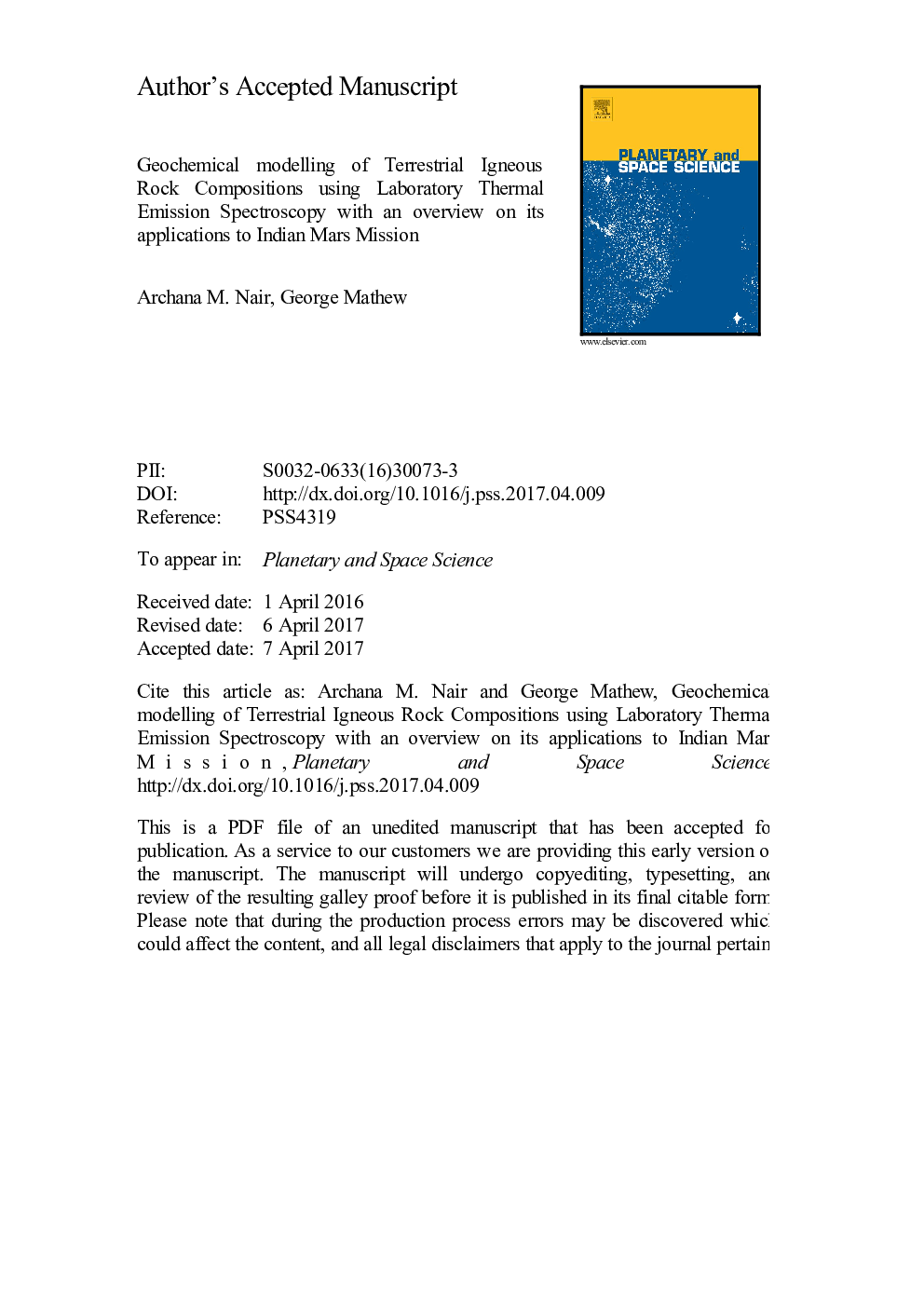| کد مقاله | کد نشریه | سال انتشار | مقاله انگلیسی | نسخه تمام متن |
|---|---|---|---|---|
| 5487971 | 1523900 | 2017 | 39 صفحه PDF | دانلود رایگان |
عنوان انگلیسی مقاله ISI
Geochemical modelling of terrestrial igneous rock compositions using laboratory thermal emission spectroscopy with an overview on its applications to Indian Mars Mission
ترجمه فارسی عنوان
مدلسازی ژئوشیمیایی ساخت ترکیبات سنگ آذرین زمینی با استفاده از طیف سنجی انتشار حرارتی آزمایشگاهی با بررسی کلی در مورد کاربرد آن برای مأموریت مریخ هند
دانلود مقاله + سفارش ترجمه
دانلود مقاله ISI انگلیسی
رایگان برای ایرانیان
کلمات کلیدی
موضوعات مرتبط
مهندسی و علوم پایه
علوم زمین و سیارات
فیزیک زمین (ژئو فیزیک)
چکیده انگلیسی
We attempt geochemical modelling of igneous rock samples with a range of compositions using laboratory-generated thermal emission spectra. Igneous rock samples, plutonic and volcanic variants of alkaline and sub-alkaline composition were used for the analysis. The collected rock samples were analysed for mineralogical composition, mineral chemistry, and bulk rock chemistry using various techniques. Laboratory thermal emission spectrometer was developed by attaching an in-house fabricated emissivity apparatus to FTIR spectrometer thus, modifying the optical path of FT-IR spectrometer. Rock samples, chipped for the fresh surface, of fist size, were used to generate emissivity spectra. The emissivity spectrum of each rock sample so generated was deconvolved into its constituent minerals with the help of a spectral library of end-member minerals and using simple linear retrieval algorithm. The deconvolution was achieved by reducing RMS error while matching the measured spectrum to the modelled spectrum. Mineral chemistry and bulk rock chemistry was derived from the modelled spectrum with the help of the spectral library of end-member minerals developed by ASU, USA. We applied the existing IUGS classification scheme for all the analysed rock samples based on bulk rock chemistry derived using thermal emission spectroscopy and compared with measured bulk chemistry from XRF. The method is found to be useful in the classification of both plutonic and volcanic rock types within an error limit of 1Ï. The classification is effective in differentiating alkaline rock types from sub-alkaline varieties. Measured and modelled silica percentage is found to be closely matching whereas total alkali shows over and under estimation. The emissivity spectra of collected rock samples were resampled to 12 bands corresponding to the spectral bands of Thermal Infrared Imaging Spectrometer (TIS) onboard Indian Mars Orbiter Mission. The analysis shows that TIS will be able to differentiate major Martian surface compositions. Consequently, we believe that the instrument will help us to improve our understanding on Martian surface in particular and its evolution and crustal differentiation in general.
ناشر
Database: Elsevier - ScienceDirect (ساینس دایرکت)
Journal: Planetary and Space Science - Volume 140, June 2017, Pages 62-73
Journal: Planetary and Space Science - Volume 140, June 2017, Pages 62-73
نویسندگان
Archana M. Nair, George Mathew,
